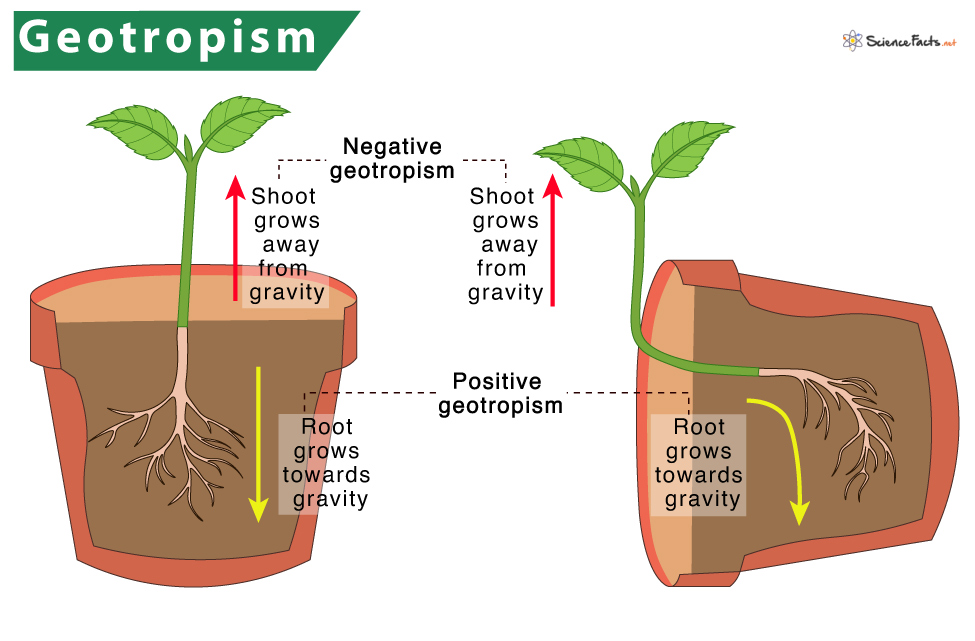Geotropism
What is Geotropism
Geotropism, also known as gravitropism, is a type of tropic movement in which plant plants grow in response to gravity. It is mainly observed in the growing parts of the plant, such as root and shoot.
In the terms ‘geotropism’ or ‘gravitropism’, the words ‘geo’ and ‘gravi’ correspond to ‘earth’ and ‘gravitational force’ respectively. The other word ‘tropism’ refers to the ‘tropic movement’, i.e., directional growth of plant parts in response to any external stimulus, such as light, water, touch, chemical, or gravity.
Charles Darwin first documented this tropic movement.
Its Types
Based on whether the plant part moves towards or away from gravity, geotropism can be of two types:
1. Positive geotropism: Here, the plant part grows towards the direction of gravitational pull, i.e., downwards. Example: Growth of roots into the soil towards gravity.
2. Negative geotropism: On the other hand, in this type, the plant part tends to grow away from the gravitational force, i.e., growing upwards. Example: Growth of stem in the opposite direction of gravity.
How Does It Work in Plants
Plants respond to gravity due to amyloplasts or statoliths in them. Statoliths are modified amyloplast, specialized starch-filled plastids that settle at the bottom of cells in roots and shoots. These are gravity-sensing organelles, which pull the plant part towards or away from the gravitational force.
As statoliths are dense particles, the gravitational pull is strong on them. As a result, they settle at the bottom of cells in both roots and shoots.
When the statoliths settle at the bottom in the roots and shoots of plants, they come in contact with the endoplasmic reticulum (ER). As a consequence, calcium ions release from the ER lumen. This calcium signaling in the cells sets off a chain of reactions, ultimately leading to the release of the growth hormone indole acetic acid (IAA), a type of auxin, to the bottom of the cell.
In roots, this IAA restricts growth on the extremities of the root and increases growth on the top part, sending it downward. On the other hand, in shoots, a higher concentration of IAA stimulates the apical cell expansion and causes the shoot to grow up.
After the shoot or root begin to grow vertically, the amyloplasts return to their normal position.
Importance of Geotropism
As seen, geotropism is a natural phenomenon in a plant. So, if the habitual growth pattern of the plant is disturbed anyway, it will reorient its parts in the right direction. For instance, if a potted plant is flipped on its side, it can be observed that the plant has directed its root and shoot system accordingly.
Let us discuss another example. A tree in the forest that sprouts on a hill may begin to grow horizontally, but over time its cellular mechanisms will lead its parts to grow in the right direction as well.
In Roots
Geotropism in root directs its growth into soil, thus enabling it to collect water and minerals as required. It also helps the plant to stand upright, as the root penetrates deep into the soil.
In Shoots
Geotropism orients the shoot away from gravity to maximize its contact with sunlight. This helps the plant to photosynthesize, bloom, and fruit.
FAQs
Ans. The combination of phototropism and geotropism allows plants to grow in the correct direction.
Ans. The fundamental difference between phototropism and geotropism is their respective stimulus. In phototropism, the growth of plants occurs towards or away from light, whereas, in geotropism, the plants grow towards or away from gravity.
-
References
Article was last reviewed on Monday, January 31, 2022




